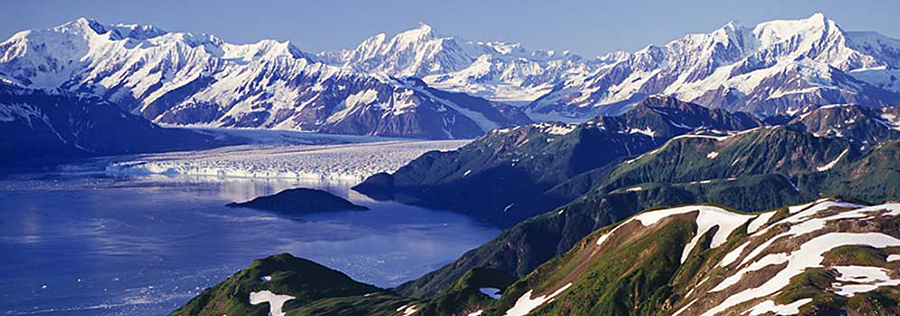FAQ: Kenai Fjords National Park
| |
Q:
A: |
Where is the Kenai Fjords National Park?
Kenai Fjords National Park is located just outside the town of Seward in southcentral Alaska, 127 miles south of Anchorage. Seward is accessible year-round via the Seward Highway, a National Scenic Byway with stunning views of the Chugach Mountains, Turnagain Arm, Kenai Lake, glaciers and wetlands. |
|
| |
Q:
A: |
How do I get to Kenai Fjords National Park?
The national park area is easily accessible via the paved Seward Highway or with the Alaska Railroad.
Railroad
The Coastal Classic Train is a local favorite that winds through the stretch of wilderness between Anchorage and Seward. A string of massive glaciers visible from the track enriches the journey. This train travels to the shores of Resurrection Bay for convenient connection to Kenai Fjords National Park, whale watching, sea kayaking, tidewater glacier viewing, fishing, and dog sled rides. Daily departures from Anchorage.
Motorcoach and Van Service
Daily departures from Anchorage. Effortlessly transition from Seward to Anchorage with our comfortable motorcoach transfer. Relax and enjoy the scenic journey as our experienced drivers navigate the picturesque landscapes between these two Alaskan destinations.
Rental Car
Rent a car, van, or 4x4 in Anchorage and drive to the Kenai Fjords National Park. A limited number of one-way rentals are available between Anchorage and Seward or VS.
Embark on an extraordinary Alaskan adventure with our captivating road trips and scenic Alaska railroad tours, both commencing or concluding in the vibrant city of Seward. Seward is the ideal place to visit before or after your Inside Passage Cruise. Immerse yourself in the grandeur of Alaska's landscapes, whether navigating the open road or enjoying the comfort of a rail journey. These carefully curated tours promise a symphony of breathtaking vistas, showcasing the unparalleled beauty of the Last Frontier. |
|
| |
Q:
A: |
Are they any points of interest on the way to Kenai Fjords National Park ?
Moose Pass: The track winds through Moose Pass, a former railroad construction camp on the shores of Trail Lake. As the rail ascends into the Kenai Mountains, it leaves behind the forests and reveals mountain meadows and streams of gin-clear glacial waters. Trail Glacier appears on the right and soon after, the summit of Grandview at 1,063 feet and the historic Loop District - named for a complex series of trestles built to handle the steep grade in the age of steam engines. In the same stretch, Bartlett Glacier crowds the track just 800 feet away.
Placer River Valley: After passing through a series of short tunnels, the track descends to the Placer River Valley near Spencer Glacier. Moose, bear and wolves populate the valley among the willow and alder trees. Trumpeter swans migrate through in spring and fall and arctic terns hover above the ponds and river looking for small fish and insects. Twelve miles later Turnagain Arm appears, where 40-foot tides rush into the narrow confines of the Chugach Mountains. Beluga whales pursue salmon and other schooling fish. Next comes Girdwood, home to Alaska's premier ski resort, a 40-mile commute from Anchorage.
The Chugach National Forest: borders Turnagain Arm, some six million acres, the second largest in the U.S. Bald eagles cruise the thermals above and Dall sheep come to feed on the low plants growing on the cliffs bordering the track. Next comes Potter Marsh in the Anchorage Coastal Wildlife Refuge.
The Portage Glacier: Find out why Portage Glacier is one of Alaska's most popular attractions. Visit the sheer, awesome face of a mighty Alaska glacier located just an hour from Anchorage. Cruising across Portage Lake on the mv Ptarmigan, you'll stand just 300 yards from a relic of the Ice Age and watch for fractures of ice break off the glacier and crash into the water below. Before you leave check out the Begich Boggs Visitor Center. |
|
| |
Q:
A: |
What can I do within the Park?
Kenai Fjords National Park is open year-round; however, the road to Exit Glacier is closed to cars for the winter months and much of the spring. The park's coastal backcountry is also inaccessible late fall through early spring due to rough seas. Kenai Fjords National Park has something for everyone. Whether you take a boat tour or kayak in a remote fjord, you will be surrounded by pristine scenery and abundant wildlife. A hike to the top of the Harding Icefield Trail or scenic overflight gives you a window to past ice ages. At Exit Glacier you can stroll the trails, take a ranger-led walk, and get close enough to hear the creaks and groans of an active glacier as it slowly sculpts the landscape. Although much of the park is rugged wilderness, there are ways to explore for all interests and abilities.
Boat Cruises: Depart Seward's small boat harbor daily in the summer months. It's a good idea to make reservations in advance. Several companies provide a variety of tour options, schedules, and amenities. Full-day tours that venture out to the park's tidewater glaciers at Aialik Bay, Holgate Glacier and Northwestern Fjords are available as well as half-day tours that stay in the more protected waters of Resurrection Bay while giving you a taste of the park's wildlife and scenery.
Kayaking: Traveling with a guide is strongly recommended for inexperienced paddlers. The fjords are exposed to the Gulf of Alaska, with only a few protected coves. These are not waters for beginners! Landings often involve surf, particularly when afternoon breezes kick up from the south. Wind and rainfall can be excessive, and summer storms often push an ocean swell of three feet or more into the fjords.
Most kayakers access the park by water taxi or charter boat from Seward and get dropped off in Aialik Bay or Northwestern Lagoon. Another alternative is to fly in to the less-visited Nuka Bay area from Homer. Paddling directly from Seward is okay for day trips in Resurrection Bay or overnight visits to Caines Head or Bear Glacier, but rounding Aialik Cape in a kayak is not recommended. There are long stretches of exposed coastline with no landing sites between Callisto Head and Aialik Cape, and the waters around the Cape can be extremely treacherous. Smaller charter boats are also available. During the shoulder seasons and winter months, some companies offer tours traveling the shorter routes in Resurrection Bay.Fishing: The area surrounding Kenai Fjords National Park has outstanding opportunities for both fresh and salt water fishing. Within the park's backcountry you can fish for salmon and Dolly Varden per state regulations. The fjords and Resurrection Bay are hotspots for salmon, halibut, rockfish, and lingcod. You can fish right from shore in Seward and opportunities abound for freshwater fishing in the lakes and streams in nearby Chugach National Forest. |
|
| |
Q:
A: |
How about wildlife viewing within Kenai Fjords National Park?
Kenai Fjords National Park is dominated by a glaciated landscape. The park's glaciers have retreated through the twentieth century, exposing new lands to colonization by plant and animal life. The park also features a significant marine environment. Large terrestrial mammals in the park include Alaskan brown bears, American black bears, moose and mountain goats. Smaller mammals include beaver and river otter. Marine mammals include sea otters,harbor seals and Steller sea lions. Cetaceans seen in park waters include orcas, fin whales, humpback whales, minke whales, Dall's porpoises and Pacific white-sided dolphins. Bird life at Kenai Fjords includes bald eagles, the Peale's subspecies of peregrine falcon, black-billed magpies, and Steller's jays. Maine birds include tufted and horned puffins, common and thick-billed murres, and marbled murrelets.
The plant communities at Kenai Fjords are shaped by glacial retreat. New lands exposed in former glacier beds are at first stony, lacking in soil. The first plants to appear in recently glaciated areas are lichens and mosses, with a few hardy plants such as dwarf fireweed and yellow dryas. These pioneers are followed by other plants as the moss and lichen break rock down into soil. In particular, Sitka alder is capable of fixing nitrogen, supporting itself and enriching the soil. Willows also appear at this stage. Willows and alders are followed by black cottonwoods, then Sitka spruce. The mature forest features Sitka spruce and mountain hemlocks, with an understory of Devil's Club, Alaska blueberry, elderberry, baneberry, watermelon berry and lady fern in the coniferous forest understory. A similar succession pattern is seen at the park's nunataks, exposed rock outcroppings in the Harding Icefield.
Forested portions of the park are dominated by conifers, with deciduous forests confined to areas recently vacated by glaciers. Harsh conditions at higher altitudes limit tree growth above the tree line, creating an alpine ecosystem. The tree line at Kenai Fjords is between 750 feet (230 m) and 1,000 feet (300 m) above sea level. The alpine regions support shrubby grown to alders, Devil's club, elderberry, lady fern, cow parsnip and other plants. Herbaceous plants can grow in areas with better soils, supporting grasses, Nootka lupine, fireweed and other perennial plants. Higher alpine regions support a dwarf shrub community less than 1 foot (0.30 m) high, at a very slow rate of growth. Dwarf plants in this region include bog blueberry, partridgefoot, black crowberry and Aleutian mountainheath, all of which are vulnerable to damage from foot traffic. |
|
| |
Q:
A: |
Are any hotels directly in the Park?
Only two remote wilderness lodges are operating within the national park boundaries. Thus, many hotels are located within the Seward city limits. |
|
| |
Q:
A: |
How about Seward?
Located at the terminus of both the Alaska Railroad and the Seward Highway, and an embarkation and disembarkation port for many cruises, this town of 2,619 residents is easily accessible from Anchorageyet can serve as a base for anybody who likes to kayak, hike, fish, whale-watch and glacier-view. Overshadowing Seward is Mount Marathon, the scene of one of Alaska’s most famous and challenging foot races. A friendly wager in 1909 resulted in this annual 3.1-mile run to the top of the 3,022-foot peak. The race attracts advanced runners from all over the world and is a highlight of Seward’s lively Fourth of July celebration, one of the best in Alaska. Seward was founded in 1903, when settlers arrived to plot construction of a northbound rail line. By the time the Alaska Railroad was completed in 1923, this ice-free port became the most important shipping terminal on the Kenai Peninsula. The city also served as the southern terminus of the 1,200-mile Iditarod National Historic Trail to Nome, long a major dogsled thoroughfare via the Interior and Bush. Like many towns in Southcentral Alaska, Seward began a new era of history in 1964 after the Good Friday Earthquake caused fires and tidal waves that destroyed 90 percent of the town. One of the only reminders of the natural disaster is in the public library where the slide show covering the earthquake, “Waves Over Seward,” is shown. |
|

